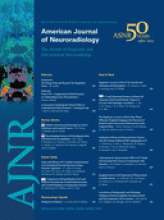Review ArticleReview Articles
Open Access
Neuroimaging Features of Neurodegeneration with Brain Iron Accumulation
M.C. Kruer, N. Boddaert, S.A. Schneider, H. Houlden, K.P. Bhatia, A. Gregory, J.C. Anderson, W.D. Rooney, P. Hogarth and S.J. Hayflick
American Journal of Neuroradiology March 2012, 33 (3) 407-414; DOI: https://doi.org/10.3174/ajnr.A2677
M.C. Kruer
N. Boddaert
S.A. Schneider
H. Houlden
K.P. Bhatia
A. Gregory
J.C. Anderson
W.D. Rooney
P. Hogarth

References
- 1.↵
- McNeill A,
- Birchall D,
- Hayflick SJ,
- et al
- 2.↵
- Yilmaz A,
- Budak H,
- Longo R
- 3.↵
- 4.↵
- Miszkiel KA,
- Paley MN,
- Wilkinson ID,
- et al
- 5.↵
- Waldvogel D,
- van Gelderen P,
- Hallett M
- 6.↵
- Brar S,
- Henderson D,
- Schenck J,
- et al
- 7.↵
- Gerlach M,
- Ben-Shachar D,
- Riederer P,
- et al
- 8.↵
- Kobari M,
- Nogawa S,
- Sugimoto Y,
- et al
- 9.↵
- 10.↵
- Hallgren B,
- Sourander P
- 11.↵
- Aquino D,
- Bizzi A,
- Grisoli M,
- et al
- 12.↵
- Boddaert N,
- Le Quan Sang KH,
- Rötig A,
- et al
- 13.↵
- 14.↵
- Gregory A,
- Westaway SK,
- Holm IE,
- et al
- 15.↵
- 16.↵
- Zhou B,
- Westaway SK,
- Levinson B,
- et al
- 17.↵
- Freeman K,
- Gregory A,
- Turner A,
- et al
- 18.↵
- Kumar N,
- Boes CJ,
- Babovic-Vuksanovic D,
- et al
- 19.↵
- Kruer MC,
- Hiken M,
- Gregory A,
- et al
- 20.↵
- Hayflick SJ,
- Hartman M,
- Coryell J,
- et al
- 21.↵
- 22.↵
- 23.↵
- 24.↵
- Morgan NV,
- Westaway SK,
- Morton JE,
- et al
- 25.↵
- Wild EJ,
- Mudanohwo EE,
- Sweeney MG,
- et al
- 26.↵
- Chinnery PF,
- Crompton DE,
- Birchall D,
- et al
- 27.↵
- di Patti MC,
- Maio N,
- Rizzo G,
- et al
- 28.↵
- Merle U,
- Tuma S,
- Herrmann T,
- et al
- 29.↵
- Kruer MC,
- Paisán-Ruiz C,
- Boddaert N,
- et al
- 30.↵
- 31.↵
- Behrens MI,
- Brüggemann N,
- Chana P,
- et al
- 32.↵
- 33.↵
- Kuo YM,
- Hayflick SJ,
- Gitschier J
- 34.↵
- Kruer MC,
- Gregory A,
- Hogarth P,
- et al
- 35.↵
- 36.↵
- Paisan-Ruiz C,
- Bhatia KP,
- Li A,
- et al
- 37.↵
- Kurian MA,
- Morgan NV,
- MacPherson L,
- et al
- 38.↵
- Paisán-Ruiz C,
- Li A,
- Schneider SA,
- et al
- 39.↵
- Galvin JE,
- Giasson B,
- Hurtig HI,
- et al
- 40.↵
In this issue
Advertisement
M.C. Kruer, N. Boddaert, S.A. Schneider, H. Houlden, K.P. Bhatia, A. Gregory, J.C. Anderson, W.D. Rooney, P. Hogarth, S.J. Hayflick
Neuroimaging Features of Neurodegeneration with Brain Iron Accumulation
American Journal of Neuroradiology Mar 2012, 33 (3) 407-414; DOI: 10.3174/ajnr.A2677
0 Responses
Jump to section
Related Articles
- No related articles found.
Cited By...
- Early Neuroimaging Markers in {beta} Propeller Protein-Associated Neurodegeneration
- Cross-sectional Observations on the Natural History of Mucolipidosis Type IV
- Genetic Risk for Hemochromatosis is Associated with Movement Disorders
- Imaging Patterns Characterizing Mitochondrial Leukodystrophies
- Quantification of different iron forms in the aceruloplasminemia brain to explore iron-related neurodegeneration
- Autophagy in the mammalian nervous system: a primer for neuroscientists
- 13-year diagnostic delay as cerebral palsy of an Iraqi patient with NBIA type 4
- Brain MR Imaging Findings in Woodhouse-Sakati Syndrome
- Transient swelling in the globus pallidus and substantia nigra in childhood suggests SENDA/BPAN
- Cortical pencil lining in neuroferritinopathy: A diagnostic clue
- Pediatric movement disorders: Five new things
This article has not yet been cited by articles in journals that are participating in Crossref Cited-by Linking.
More in this TOC Section
Similar Articles
Advertisement











